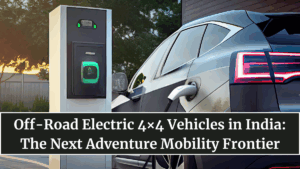Adventure meets innovation in a brand-new way as India steps into the age of electric off-roading. The India off-road electric 4×4 growth trend is picking up speed, blending rugged adventure with clean technology. From electric SUVs designed for tough terrains to 4×4 EV prototypes under testing, manufacturers are reimagining what it means to go off-road — this time, without a roar but with a silent surge of torque.

The Rise of Electric Off-Roading
India’s off-road community has always been strong, powered by iconic vehicles like the Mahindra Thar and Force Gurkha. Now, that passion is shifting toward sustainable innovation. As global automakers invest in electric adventure vehicles, Indian brands are following suit with prototypes that promise instant torque, zero emissions, and minimal maintenance — ideal for rugged conditions and long-range adventures.
The government’s push for EV adoption and the rise of domestic cell manufacturing have accelerated R&D into off-road capable electric platforms. For the first time, Indian automakers are exploring 4×4 drivetrains powered entirely by electric motors — opening up a new segment for eco-conscious adventure enthusiasts.
Key Players and Upcoming 4×4 EV Models
Major automakers and startups are already preparing to electrify the off-road experience.
| Manufacturer | Model / Concept | Expected Launch | Highlight Features |
|---|---|---|---|
| Mahindra | Thar EV (Vision Thar.e) | 2026 | AWD, dual motor setup, 4×4 terrain management system |
| Tata Motors | Sierra EV | 2025 | Dual motor option, rugged design for adventure |
| Maruti Suzuki | eJimny Concept | Under development | Lightweight, compact off-road EV |
| Ultraviolette Automotive | Project ADV | 2025 (expected) | Electric adventure bike, long range & waterproof battery |
| Force Motors | Electric Gurkha (pilot) | In testing | Heavy-duty 4WD electric variant for rural & expedition use |
These vehicles are being designed not just for city commutes but for mountain trails, deserts, and long-distance drives, marking a new phase in India’s EV mobility journey.
Why Electric 4×4s Make Sense for India
While off-roading is often associated with power-hungry diesel engines, electric technology actually suits rugged driving remarkably well:
-
Instant torque delivery gives immediate traction on rough terrains.
-
Simpler drivetrain mechanics reduce mechanical wear and maintenance.
-
Better weight distribution due to low-mounted batteries improves stability.
-
Silent operation enhances nature exploration experiences.
-
Regenerative braking improves energy efficiency on steep declines.
These advantages are encouraging automakers to invest in new architectures built specifically for off-road electric performance.
Challenges Holding Back Adoption
Despite growing enthusiasm, electric 4×4 vehicles face several real-world challenges in India:
-
Limited charging infrastructure in remote or mountainous regions.
-
High vehicle costs due to dual motor systems and large battery packs.
-
Range anxiety for long expeditions away from cities.
-
Battery protection and waterproofing needed for extreme conditions.
-
Lack of government-specific incentives for off-road or adventure EVs.
To overcome these, automakers are exploring portable charging units, solar-based recharging systems, and battery-swapping solutions suited for rural and off-grid environments.
The Growing Off-Road EV Ecosystem
Beyond vehicles, a new ecosystem is forming around India’s off-road EV future. Adventure tourism startups are planning EV-only expedition routes, while charging companies are mapping remote stations along travel corridors in Himachal, Ladakh, and the Western Ghats.
Additionally, innovations in solid-state batteries, enhanced suspension systems, and modular body designs are helping EVs handle tough terrains more effectively. Workshops and off-road clubs are beginning to train drivers in electric vehicle recovery, maintenance, and charging in wild environments — a niche but growing community of the future.
The Road Ahead
By 2030, experts predict that electric 4×4 and adventure vehicles could account for 15–20% of India’s premium EV segment. With more models entering the market, affordability will improve, encouraging widespread adoption among enthusiasts.
The combination of government policy, green innovation, and the timeless Indian love for exploration is creating a whole new adventure era — one that’s powerful, sustainable, and thrillingly quiet. The future of off-roading in India isn’t just rugged — it’s electric.
FAQs
What makes electric 4×4 vehicles suitable for off-roading?
Instant torque, low center of gravity, and improved traction make EVs perfect for off-road terrain.
Which companies are developing off-road EVs in India?
Brands like Mahindra, Tata Motors, and Force Motors are leading the charge with models like the Thar EV and Sierra EV.
When will electric off-road vehicles launch in India?
Most models, including the Thar EV and Sierra EV, are expected between 2025 and 2026.
Are electric 4×4 vehicles expensive?
Yes, initially. Due to large batteries and dual-motor systems, prices are higher, but costs are expected to drop as production scales.
What’s the biggest challenge for off-road EVs in India?
Lack of charging infrastructure in remote areas remains the main hurdle for widespread adoption.
Click here to know more.
